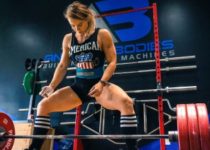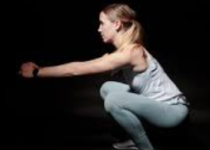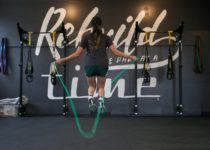The Best Bodyweight Leg Workout - No Matter What Level
Training your legs with your own body as the only tool can be quite challenging. Especially if you're advanced in terms of strength, it can be tough to find the right exercises.
In this article, you are going to get a full workout plan for your legs, that you can adjust to your current level!
How To Warm Up
When training any kind of muscle group, it is important to warm-up properly. But how do you warm up properly?
It is essential to break down the warm-up into two separate phases to get the most out of it. Studies have shown that you can increase your physical performance by 10-20% only by doing the right warm-up.
Divide your warm-up into the two following phases.
Activate your Cardiovascular System
As the name suggests, it is best to start with steady-state cardio. Slow jogging and other types of movements that activate major muscle groups work best.
The intensity should be comparably low while you do the activity for at least 5 minutes. This is going to increase your heart rate and bloodflow around your muscles, which helps both with injury prevention & your physical performance!
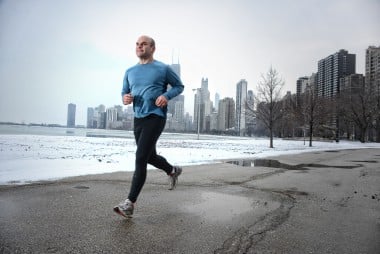
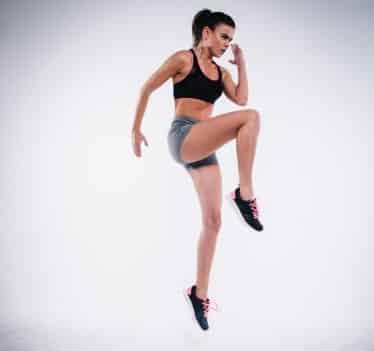
Activate the muscle groups that you will train
Once the cardiovascular system is warm, you should warm-up the muscle groups that you are about to train specifically. Since you are warming up for a leg workout, you should do some easy exercises that engage the major muscle groups around your legs
Do 1-2 sets of exercises for your;
- Quadriceps
- Hamstrings
- Calves
- Glutes
- Hip Flexors

This doesn't necessarily mean that you have to do 5 separate exercises. Fortunately, many exercises work on multiple muscle groups simultaneously.
The Warm-Up:
- 5 Minutes of Slow Running
- 10 Bodyweight Glute Bridge
- 20 Squats
- 20 Calf Raises
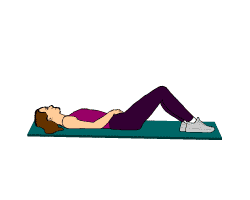

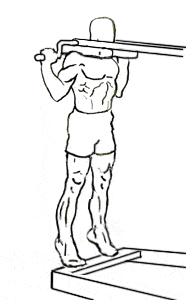
The Exercises
Now that we've covered how to warm-up, you are going to find a list of the best leg exercises & how to perform them the right way.
Further down, you will find three different workouts ranging from beginner to advanced. Also, there are going to be tips on how to make the workout easier or harder if necessary.
Squats
Probably the most popular exercise on the list are squats. To perform a squat, you start by standing with your legs at shoulder-width apart. You should be looking forward while maintaining an upright posture.
Then slowly lower your bottom towards the ground while keeping your knees pointing outwards and your heels on the floor. It is important that your back stays straight at all times.
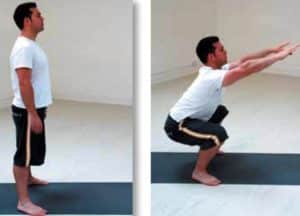

Sumo Squats
The sumo squat is a variation of the regular squat, with the primary difference that your stance is broader. Furthermore, your toes should be pointing outwards. Use the full range of motion, whereas your thighs have to be parallel to the floor at the lowest point of the squat.
This exercise is going to put more emphasis on your hamstrings & glutes as the regular squat and is also more challenging to perform correctly.
Lunges
Another great leg exercise for your hamstrings & quads are lunges. Start with both feet together and take a big step forward while the heel of your back leg is in the air. Slowly lower yourself down, while most of your weight should be on your front leg. Try to touch the floor with the knee of your back leg without putting actual pressure onto the floor with that knee. Go back to both feet and repeat the same exercise with the other leg.


Pistol Squats
Pistol Squats are the most advanced variations of squats; since you perform the same motion as in a regular squat with one leg.
The leg that doesn't touch the ground should be straight and in front of you at all times, which requires some basic flexibility. Focus on keeping your knee as stable as possible while slowly lowering yourself down until your bottom nearly touches the floor. Then go all the way up until your knee is nearly straight, while keeping your back straight at all times.
Bodyweight Glute Bridge
When it comes to building your hamstrings, glutes, but also hip flexors, one of the best exercises to do is the bodyweight glute bridge.
Start by laying on your back with your knees bent. Now push your hips up towards the ceiling until your thighs, and lower back is in a straight line. Hold the motion at the top for 1-2seconds before slowly lowering yourself down.
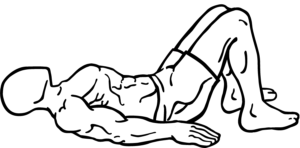
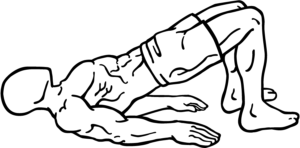
Single-Leg Glute Bridge
If you want to work on your stability & need a more advanced exercise, the single-leg glute bridge is going to be the best option. Do the exact same exercise, but with only one leg. Keep the other leg straight and above the hip level while the other leg performs the glute bridge.
Nordic Hamstring Curls
Nordic Hamstring Curls are by far one of the most challenging hamstring bodyweight exercises that you could find. With this exercise, you are going to need a partner or something to push your legs towards the floor.
Start on your knees with your feet locked to the floor (or held by a partner). Now slowly try to lower your upper body towards the floor. Your hamstrings & lower back should be in alignment while you are doing the exercise.
Calf Raises
One of the most efficient ways to train your calves is by doing calf raises. Depending on your skill level, you can do this exercise either on both feet or only one foot at a time.
Stand on a curb/low box/slight elevation on the balls of your feet. Your heels are going to be in the air the entire time. Slowly try to go as far onto your toes as you can and then slowly lower your heels down as far as you can go.
Cool Down
After any type of workout, it is important to do a short cooldown to allow your body to recover more quickly. In this case, steady-state cardio and light stretching work best.
- 5 minutes of SLOW running
- Straight leg swings (sideways, forwards & backward) (10x each leg)
- Straddle Stretch (20sec)
- Lunge Stretch (20sec each leg)
The Workout
Do 3 sets of each exercise with 8-12 repetitions in each set.
Beginner:
- Lunges
- Squats
- Bodyweight Glute Bridge
- Calf Raises
Intermediate:
- Sumo Squats
- Lunges
- Single-Leg Glute Bridge
- Single-Leg Calf Raises (use hands for wall support)
Advanced
- Pistol Squats
- Lunges
- Nordic Hamstring Curls
- Single-Leg Calf Raises
How To Adjust The Difficulty:
- Add weights
Although this workout is a bodyweight workout, you can add weights if available for nearly any of the exercises. Weight vests, or even a heavy backpack, can increase the difficulty if you don't have dumbbells.


- Unstable Surface
To make exercises more challenging and also engaging for your stabilizing muscles, you can do the exercises standing on a pillow/unstable surface.
- More/Fewer Repetitions
- Add a static element
At the hardest part of the exercise, you can add a short static hold for 2-3 seconds to increase the difficulty
- Use an elastic band
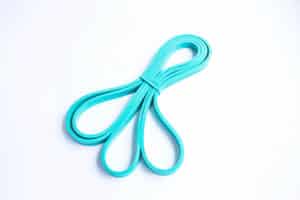
Conclusion
If you follow this workout, you are going to progress fast. Remember to choose a level that suits you best, as both ego lifting & underestimation lead to stagnation.
Feel free to leave a comment below if any unanswered questions remain. Also, share this article with your friends if they might find it helpful!
